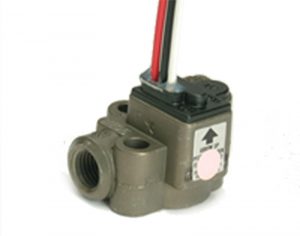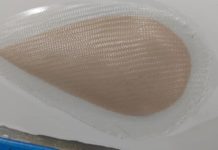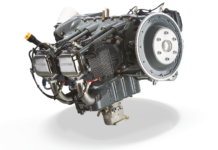Written by Mike Palmer, Glasair I/II.
Fluctuating Fuel Pressures
For the longest time, we had a problem with our fuel pressure (carbureted engine). Occasionally, the fuel pressure would fluctuate wildly, with a set frequency. It didn’t seem unsafe (an advantage of carburetors!), but unexpected and annoying. Turning on the electric pump didn’t seem to make a difference.
I never could quite predict when it was going to happen, although it seemed to happen most predictably when we were full of fuel and climbing. From that, I figured it was a vent problem. Perhaps a slug of fuel got into those long lines in the wing vent and made it hard for the fuel pump to work, resulting in the pressure fluctuation.

Well, we found the problem, serendipitously. We have a Floscan fuel-flow transducer and had mounted it inside the firewall, just before a right-angle bulkhead fitting. (We were using the old G-I fuel firewall pass-through.) The fuel-flow gauge has never been right, and I thought perhaps the problem was due to mounting that Floscan so close to a right angle. (You’re supposed to have it mounted with a few inches of straight line before and after the transducer.) So, I moved it further upstream, where I had a straight section of fuel line.
I don’t know if that did it, or if it was the fact that one of the AN fittings on the Floscan was “loose,” but the problem is solved. Our fuel pressure is now rock solid.
In previous issues of the Glasair News (really old ones) there was some discussion about how a tiny leak in a fuel fitting could be small enough not to pass fuel but big enough to allow air to be drawn in. (This was before S-H had moved the location of the electric fuel pump on the old G-Is.) We had just the tiniest hint of weeping fuel at the fitting. As our Floscan was located before the mechanical fuel pump, perhaps we were sucking a little air?
That seems the most plausible theory, but if that’s not it, maybe having the Floscan mounted so close to the right-angle fitting was causing some pulsating turbulence in the fuel line? I don’t really know, but if you’re having fluctuating fuel problems, I’d suggest checking your fittings for tightness first, and if that doesn’t do it, maybe try bypassing your Floscan if you have one.
Cermi-Chrome
This has nothing to do with Glasairs per se, but be on the lookout for extreme cylinder wear on early Cermi-chrome cylinders. We were one of the first to get Cermi-chrome, back in ’88. As usual, we didn’t get flying until ’95, and by that time, they had found out about the ring incompatibility.
In our case, we’ve been playing “catch up” with all you builders who finished before us, and had 360 hours after a year-and-a-half. Everything was looking good engine-wise, with hardly anything in the oil filter. Then, at about 320 hours, we started getting a few flakes of “stuff”. We do oil analysis, but after establishing a baseline, only send in every other sample. Flew to Florida and back, and upon return, found more stuff in the oil filter, and sent that oil sample in. Got a call back that chrome and iron content were too high, suggesting cylinder wear-through.
Upon pulling the jugs, we found that was right. All four cylinders had begun stepping. Sigh. Because of time constraints and previous commitments, we decided to opt for new Millenniums. But if you have Cermi-chrome, beware.
Hard Starting
I was beta-testing a new electronic mag when our engine became harder to start. It was getting to be “winter” here in Phoenix (where the temps drop into the 40s in the morning—brrrr…), we have no primer, and I had changed to longer-reach spark plugs for the new ignition. Between all that, I wasn’t sure what the problem was. If anything, this new ignition should have made the engine easier to start.
When I got to Florida, where it’s warmer than Phoenix in the winter, I took a fellow involved with this new ignition system up for a flight. The engine wouldn’t start there either. He said he knew exactly what the problem was.
Turns out the nozzle for the accelerator pump had plugged with something. (I wish I’d seen what was plugging it, but he blew it out before I had the chance to stop him.) In fact, it was so plugged, that the pressure from the accelerator pump had split the tubing, and fuel would spill out the bottom of the carb.
As a temporary fix, we simply cut the tubing—but considering that this made for a bigger nozzle and seems to work fine, it may become permanent.
So, if your engine is hard to start, check to see if your accelerator pump is really pumping. And pumping where you want it to.
Stumbling Engine
This same fellow, who so correctly diagnosed our starting problem, also suggest we switch to a K&N air filter. (He was concerned that the paper Fram filter we were using would clog up after flying in rain.) These K&N units are used by hot rodders and also Van’s RVs. He suggested that when we switch, we also make a front baffle for the airbox, so as to not let air impact directly on the filter element.
So we made the change, and obediently put in a baffle. The air filter may be good, but the baffle wasn’t. (Since putting in the new air filter, we find that we have to run richer. Maybe we were starving for air before?) The engine really ran rough from 2,200 to 2,500 r.p.m..
I cut out the baffle, and voila—the engine runs much better. It’s amazing how sensitive a carburetor is to air flow.
Electro-Mag
The new electronic ignition I’ve been testing is called an “Electro-Mag.” It’s very simple (read that: “reliable”). It doesn’t have any fancy microprocessors to vary your timing, which would be nice, but would also be very susceptible to interference. (Ever fly under virga in a Glasair? We really charge up the airframe, pulling sparks off metal, and driving the radios nuts.) It’s very simply a unit you bolt in place of one of your mags that has two hall-effect sensors in it and a rotor. The hall effects drive an external, oil-filled high-voltage coil, like the kind you used to have on your car in the 60s. The result is a very hot spark. (Did you know the spark from a well-tuned mag is only 8KV?) You can open the gap on your plugs to .050″. In fact, it’s so reliable that a major manufacturer is negotiating to make it a certified product for certified airplanes.
Another thing that differentiates this unit from those others on the market—it’s fully shielded. Some will warn you that you can’t run a Stormscope with their electronic ignitions, but not this one! We’ve been running our Stormscope and LORAN just fine! (One of the reasons I got to beta test this unit was for this very reason. A composite airplane presents a worse case RFI scenario.)
We’ve noticed about 10% better climb, hotter CHTs, broader leaning band, and when we pulled the pistons out for the cylinder change, a much bigger burn pattern on the Electro-Mag side. (Less lead fouling and valve sticking?)



